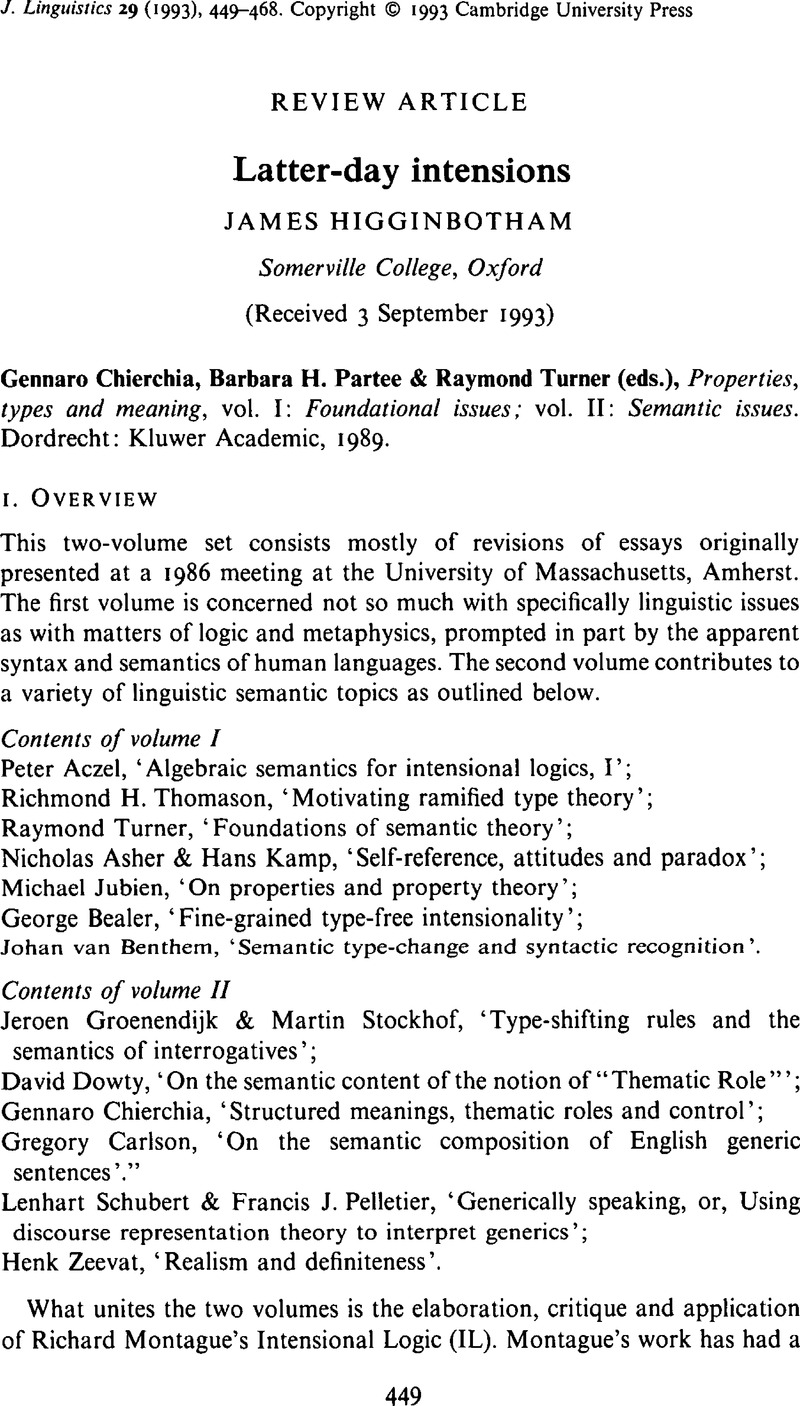No CrossRef data available.
Article contents
Latter-day intensions
Published online by Cambridge University Press: 28 November 2008
Abstract
An abstract is not available for this content so a preview has been provided. Please use the Get access link above for information on how to access this content.

Information
- Type
- Review Articles
- Information
- Copyright
- Copyright © Cambridge University Press 1993
References
REFERENCES
Belnap, N. (1982). Questions and answers in Montague grammar. In Peters, S. & Saarinen, E. (eds.) Processes, beliefs and questions. Dordrecht: D. Reidel. 165–190.CrossRefGoogle Scholar
Bennett, M. (1979). Questions in Montague grammar. Bloomington: Indiana University Linguistics Club.Google Scholar
Carlson, G. (1984). On the role of thematic roles in linguistic theory. Linguistics. 22 259–279.CrossRefGoogle Scholar
Chierchia, G. (1984). Topics in the Syntax and Semantics of Infinitives and Gerunds. Unpublished doctoral dissertation, University of Massachusetts, Amherst.Google Scholar
Chomsky, N. (1970). Remarks on nominalization. In Jacobs, R. & Rosenbaum, P. (eds.) Readings in English transformational grammar. Waltham, MA: Ginn. 184–221.Google Scholar
Davidson, D. (1967). The logical form of action sentences. In Rescher, N. (ed.) The logic of decision and action. Pittsburgh, PA: University of Pittsburgh Press. Reprinted in Davidson (1989). 105–148.Google Scholar
Hempel, C. (1966). Philosophy of natural science. Englewood Cliffs, NJ: Prentice-Hall.Google Scholar
Higginbotham, J. (1989). Elucidations of meaning. Linguistics and Philosophy 12 465–517.CrossRefGoogle Scholar
Higginbotham, J. (1993). Interrogatives. In Hale, K. & Keyser, S. (eds.) The view from building 20: essays in linguistics in honor of Sylvain Bromberger. Cambridge, MA: MIT Press. 195–227.Google Scholar
Kartunnen, L. (1977). Syntax and semantics of questions. Linguistics and Philosophy 1. 3–44.CrossRefGoogle Scholar
Krifka, M. (1988). The relational theory of genericity. In Krifka, M. (ed.) Genericity in natural language (SNS-Bericht 88-142). University of Tübingen, 285–312.Google Scholar
Kripke, S. (1975). Outline of a Theory of Truth. The Journal of Philosophy. 72 690–715.CrossRefGoogle Scholar
Lambek, J. (1958). The mathematics of sentence structure. American Mathematical Monthly 65. 154–169.CrossRefGoogle Scholar
Larson, R., Iatridou, S., Lahiri, U. & Higginbotham, J. (eds.) (1992). Control and grammar. Dordrecht: Kluwer.CrossRefGoogle Scholar
Montague, R. (1963). Syntactical treatments of modality, with corollaries on reflexion principles and finite axiomatizability. Acta Philosophica Fennica 16. Reprinted in Montague (1974). 286–302.Google Scholar
Montague, R. (1974). Formal philosophy. Ed. Thomason, R.. New Haven: Yale University Press.Google Scholar
Montague, R. & Kaplan, D. (1960). A paradox regained. Notre Dame Journal of Formal Logic 1. Reprinted in Montague (1974). 271–285.Google Scholar
Nagel, E. (1961). The structure of science. New York: Harcourt, Brace & World.CrossRefGoogle Scholar
Parsons, C. (1974). The liar paradox. Journal of Philosophical Logic 3. Reprinted with a Postscript in Parsons, Mathematics in philosophy. Ithaca, NY: Cornell University Press, 1983. 221–267.Google Scholar
Parsons, T. (1980). Modifiers and quantifiers in natural language. Canadian Journal of Philosophy, Supplementary vol. VI. 29–60.Google Scholar
Partee, B. & Rooth, M. (1983). Generalized conjunction and type ambiguity. In Bäuerle, R., Schwarze, C. & Stechow, A. von (eds.) Meaning, use and interpretation of language. Berlin: Walter de Gruyter. 361–383.CrossRefGoogle Scholar
Prior, A. (1971). Objects of thought. Ed. Geach, P. & Kenny, A.. Oxford: Clarendon Press.CrossRefGoogle Scholar
Rappaport, M. (1983). On the nature of derived nominals. In Levin, L., Rappaport, M. & Zaenen, A. (eds.) Papers in lexical-functional grammar. Bloomington: Indiana University Linguistics Club. 113–142.Google Scholar
Szabolcsi, A. (1986). Combinatory grammar and projections from the lexicon. In Sag, I. & Szabolcsi, A. (eds.) Lexical matters. Stanford, CA: Center for the Study of Language and Information, Stanford University.Google Scholar
Thomason, R. (1980). A note on syntactical treatments of modality. Synthese 44. 391–395.CrossRefGoogle Scholar

